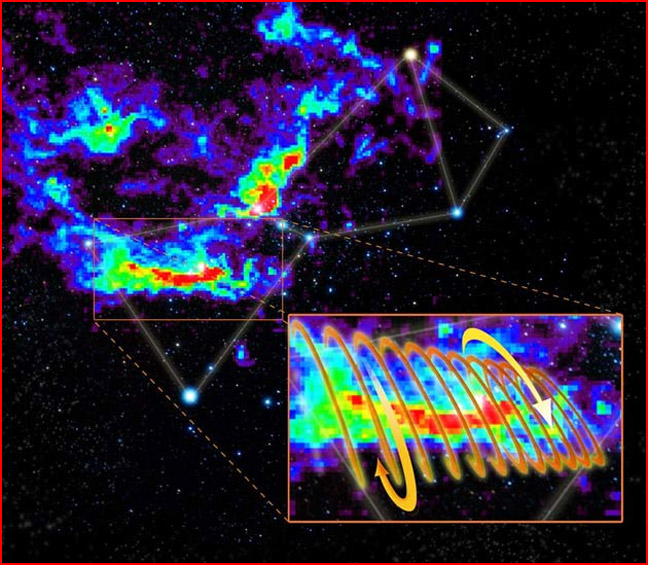
home •
about •
essential guide •
picture of the day •
thunderblogs •
news •
multimedia •
predictions •
products •
get involved •
contact
picture of the day archive subject index
The Orion Molecular Cloud
Credit: Saxton/Dame/Hartmann/Thaddeus/NRAO/AUI/NSF
Jul 19, 2006
Magnetic Vortex in Space
It has been called a “magnetic Slinky” in the Orion Molecular Cloud. But electrical theorists predict that we will discover counterparts everywhere in space if we will simply look for them.Astronomers say they have discovered a giant magnetic field that is coiled like a snake around a rod-shaped gas cloud in the constellation Orion. Timothy Robishaw, a graduate student at the University of California, Berkeley, involved in the discovery, described the structure as a "giant, magnetic Slinky wrapped around a long, finger-like interstellar cloud."
So goes the story from Space.com about the discovery of an electrical vortex whirling through the cosmos. But, as we have often noted in these pages, astrophysicists continue to misunderstand what they see because they insist on seeing gas where plasma currents flow.
Continuing with the article...“The helical shape of the magnetic field is believed to be caused by matter in the interstellar cloud moving in a straight line along the length of the filament. When this happens, it causes the magnetic field around the cloud to spiral around in a corkscrew pattern. The researchers were able to detect this spiral shape using the Green Bank Telescope, a radio observatory in West Virginia.”
This is the classic "cart-before-the-horse" argument used by astrophysicists. It relies on a magnetic field being generated and trapped mysteriously within the gas cloud, the movement of the cloud itself causing the spiral magnetic field. Nothing about the cloud – its magnetic field, its shape, its movement, or what lights it – is actually explained by this kind of argument.
The unwillingness of theorists to countenance electric currents in space prevents them from seeing the obvious: The power that forms and lights the rod-shaped gas cloud is electrical. The cloud and the magnetic field merely trace the current flow of a cosmic Birkeland current (see Figure 15.3.2). It was Kristian Birkeland in 1908 who postulated the existence of the currents that bear his name. And in 1939, Nobel Laureate Hannes Alfvén was the first physicist to promote Birkeland’s theory in a paper about electrical currents generated by the solar wind.
In electrical terms, the spiraling magnetic field of the Orion Molecular Cloud derives partly from an external field aligned with the cloud axis and partly from the toroidal field produced by the current flowing along the cloud axis. This is the way electrified plasma behaves in the laboratory. The current is strongest at the axis (shown in red) and becomes weaker further away from the axis. If astrophysicists recognized this simple fact, the glowing arms of spiral galaxies would at last be seen as electromagnetic structures, subject to electromagnetic forces. The point needs to be made again and again: In our Electric Universe there is no need for weird "dark matter."
We should look to radio astronomers, like those at the Green Bank Radio Telescope, who can map cosmic magnetic fields, for more and more evidence of cosmic Birkeland currents.
Contributed by Steve Smith
___________________________________________________________________________Please visit our Forum
The Electric Sky and The Electric Universe available now!

|
|

|
EXECUTIVE EDITORS:
David Talbott, Wallace Thornhill
MANAGING EDITORS:
Steve Smith, Mel Acheson
CONTRIBUTING EDITORS: Dwardu Cardona, Ev Cochrane,
C.J. Ransom, Don Scott, Rens van der Sluijs, Ian Tresman
WEBMASTER: Brian Talbott
Copyright 2006: thunderbolts.info
![]()
home •
thunderblogs •
forum •
picture of the day •
resources •
team •
updates •
contact us

